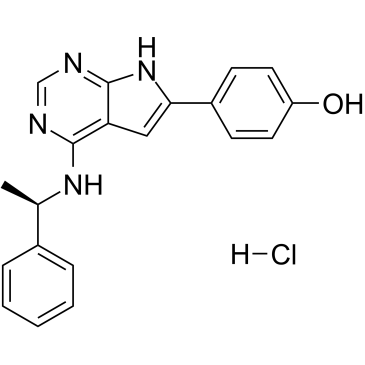PKI 166 hydrochloride
Modify Date: 2024-01-23 00:42:04

PKI 166 hydrochloride structure
|
Common Name | PKI 166 hydrochloride | ||
|---|---|---|---|---|
| CAS Number | 2230253-82-2 | Molecular Weight | 366.84 | |
| Density | N/A | Boiling Point | N/A | |
| Molecular Formula | C20H19ClN4O | Melting Point | N/A | |
| MSDS | N/A | Flash Point | N/A | |
Use of PKI 166 hydrochloridePKI-166 hydrochloride is a potent, selective and orally bioavailable EGFR tyrosine kinase inhibitor, with an IC50 of 0.7 nM[1]. |
| Name | PKI-166 hydrochloride |
|---|
| Description | PKI-166 hydrochloride is a potent, selective and orally bioavailable EGFR tyrosine kinase inhibitor, with an IC50 of 0.7 nM[1]. |
|---|---|
| Related Catalog | |
| Target |
IC50: 0.7 nM (EGFR tyrosine kinase)[1] |
| In Vitro | Pretreatment with PKI-166 hydrochloride (0-0.5 μM; 1 hour) inhibits EGFR autophosphorylation in human pancreatic cancer cells[1]. PKI-166 hydrochloride (0.03 μM; 6 days) enhances the cytotoxicity mediated by gemcitabine[1]. Western Blot Analysis[1] Cell Line: L3.6pl cells Concentration: 0.01 μM, 0.05 μM, 0.5 μM Incubation Time: 1 hour Result: Inhibited EGFR autophosphorylation in a dose-dependent manner. Cell Cytotoxicity Assay[1] Cell Line: L3.6pl cells Concentration: 0.03 μM Incubation Time: 6 days Result: Enhanced the cytotoxicity mediated by gemcitabine. |
| In Vivo | PKI-166 hydrochloride (100 mg/kg; p.o.; daily; day 7-day 35 after xenograft) inhibits of pancreatic cancer growth[1]. Animal Model: Male athymic nude mice with L3.6pl cells xenograft (8–12 weeks)[1] Dosage: 100 mg/kg Administration: Oral administration; daily; from day 7 to day 35 after xenograft Result: Significantly decreased median tumor volume. |
| References |
| Molecular Formula | C20H19ClN4O |
|---|---|
| Molecular Weight | 366.84 |